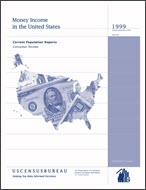Money Income in the United States: 1999
Money Income in the United States: 1999
Introduction
This report presents data on the income of households, families, and people in the United States for calendar year 1999, as well as comparisons with 1998 and, in some cases, with 1989, the previous peak year in the business cycle. Changes in income noted in this report are based on real income (after adjusting for inflation). The Census Bureau compiled these data from information collected in March Supplements to the Current Population Survey (CPS), based on approximately 50,000 randomly selected households nationwide.
The CPS demographic supplement conducted in March of each year is one of the best known and most widely used of all continuing federal household surveys. For more than 50 years, analysts, researchers, and policy makers have used the CPS to examine annual changes in income and earnings and to compare them with historical trends. Television, radio, and newspapers frequently draw upon this source for statistics on American’s jobs, income, poverty status, health insurance coverage, marital status, migration, and other characteristics.
The estimates in this report are based on interviewing a sample of the population. Respondents provide answers to the best of their ability. As with all sample surveys, the estimates may differ from the actual values. Table A presents the confidence intervals for estimates discussed in the text. Data users should consider the levels of uncertainty when using these estimates.
Highlights
(Most of the estimates described below are shown on Table A, Table B, Table E, and Appendix Table B-2; the estimates for states are shown on Table D.)
- The real median income of households in the United States rose by 2.7 percent between 1998 and 1999, from $39,744 to $40,816. This is the fifth consecutive year that household income increased.1 Real median household income is now at the highest level recorded since the Census Bureau started compiling these estimates in 1967.
- The 1999 median income was the highest ever recorded for White non-Hispanic ($44,366), Black ($27,910) and Hispanic ($30,735) households, and equaled the highest ever recorded for Asian and Pacific Islander households ($51,205).
- The 1997-1999 average household median income for American Indians and Alaska Natives was $30,784, higher than the comparable income of Blacks, not statistically different from Hispanics, but lower than White non-Hispanics and Asians and Pacific Islanders.
- Family and nonfamily households alike experienced growth in real median income between 1998 and 1999. Family household income rose 2.9 percent to $49,940; and nonfamily income rose 2.5 percent to $24,566.2
- Median household income reached new all-time highs in 1999 in the Midwest and the South. Median household income in the Northeast and West did not change between 1998 and 1999.
- For men who worked full-time, year-round, real median earnings rose from $36,126 to $36,476 between 1998 and 1999. This is the third straight year that men have experienced an annual increase in earnings. The median earnings of women working full-time, year-round remained statistically unchanged at $26,324. The female-to-male earnings ratio dropped between 1998 and 1999, from 0.73 to 0.72.3
- Analysis of aggregate shares of income and of the Gini index show that household income inequality remained unchanged between 1998 and 1999.
- Real median household income rose significantly in 14 states and the District of Columbia and did not decline in any state, based on comparisons of 2-year average medians (1997-1998 and 1998-1999). Five of the states that experienced increases are in the Midwest (Illinois, Iowa, Michigan, South Dakota, and Wisconsin), four are in the Northeast (Maine, New York, Rhode Island, and Vermont), three states (Florida, Tennessee, and Texas) and the District of Columbia are in the South, and two are in the West (Arizona and California).
- Real median household income grew by 2.0 percent/4 between 1998 and 1999 using the most comprehensive definition of income (which takes taxes and receipt of noncash benefits into account). This change is not statistically different from the 2.7 percent increase for the official measure.
- The most comprehensive income definition (one that includes the effects of taxes and noncash benefits) lowered income inequality by 8.1 percent/5 when compared to pre-tax (official) money income. Government transfers have a much greater effect than taxes on redistributing income.
__________
1 Changes in real income refer to comparisons after adjusting for inflation. The percentage changes in prices between earlier years and 1999 were computed by dividing the annual average Consumer Price Index (CPI-U) for 1999 by the annual average for earlier years. See Table B-1 in Appendix B for values of the CPI-U from 1947 to 1999.
2 The difference between the 1998-1999 percent changes in income for family and nonfamily households was not statistically significant.
3 The 90-percent confidence interval for the 1998 and 1999 female-to-male earnings ratios is ± 0.01.
4 The 90-percent confidence interval for the 2.0 percent increase is ± 0.8.
5 The 90-percent confidence interval for the 8.1 percent increase is ± 1.0.
Tables
Charts
Graphs
Press Briefing
Related Information
-
TableHistorical Income Tables: HouseholdsSource: Current Population Survey (CPS)
-
TableHistorical Income Tables: Income InequalitySource: Current Population Survey (CPS)
-
TableHistorical Income Tables: Experimental MeasuresSource: Current Population Survey (CPS)
-
TableHistorical Income Tables: PeopleSource: Current Population Survey (CPS)
-
TableHistorical Income Tables: FamiliesSource: Current Population Survey (CPS)
Others in Series
Publication
Publication
Publication







